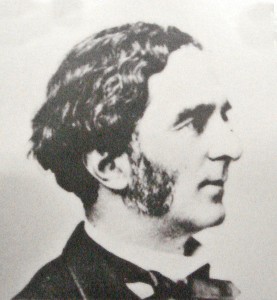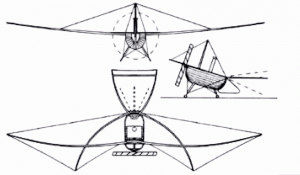Published on September 20, 2012
The machine rolled down the ramp, accelerating as the nose-mounted propeller spun furiously. At the bottom of the ramp, much like a ski jump, the track curved back upward. This launched the machine aloft whereupon its great wings, 13 meters wide, caught the air perfectly. The machine glided forward as it descended down the slope. In the boat-like fabric and wooden hull, a volunteer French navy midshipman gripped the frame and tried to manipulate the makeshift hinged elevator. Against all odds, somehow he rode to a successful landing after a short flight. Félix du Temple de la Croix, the plane’s inventor, looked on with interest. The date was September 20, 1874, and the Monoplane had flown.

Background and History
Félix du Temple de la Croix was a French naval officer born in Normandy. At age 34, he started experimenting with aviation. By 1857, he and his brother, Louis, had pioneered a working powered model airplane. It successfully flew and he filed a patent for the design. Basing the aircxraft on the shape of a bird’s wing, he fitted on a small hull and birdlike tail. At the front, he mounted an engine connected to a many-bladed fan. The first model used a clockworks device to provide wind-up power. He moved on to others forms of engines in larger models, experimenting with steam. Finding all existing steam engines too heavy, he tried a new innovation, the reciprocating gasoline engine. It too didn’t produce enough power.

Finding no engines suitable to the task at hand, Félix du Temple and his brother spent many more years working on a lightweight steam engine of their own. The idea that evolved was to use small pipes that were tightly packed into a small lightweight firebox, thus generating steam at a reasonable hp/weight ratio. Achieving a working model of the steam engine, he filed his patents for that innovation as well and then moved ahead with his full aerial design, which he called the Monoplane. The goal, however, was not to prove flight, but rather to prove the lightweight engine and it seemed that creating a large flying aircraft would be a sufficient engineering challenge to force the lightweight steam engine along its development path.

His Achievement — the Steam Engine!
Thus, Félix du Temple’s Monoplane machine and its flight were not very interesting. Instead, once the first flight was accomplished, he and his brother retired the Monoplane and abandoned further investigation into the venture of flight. In effect, there seemed little utility in continued experimentation.

Most critically, in the wake of his successful flight at Brest, France, Félix du Temple successfully sold his lightweight steam engine design to the French Navy, which was suitably impressed with his design. The steam engine was soon in use on French navy torpedo boats, which served successfully throughout the 1880s and 1890s. Flight had little military utility or value. After all, what could be achieved from a short hop off a ski jump? It would take another 29 years before the Wright Brothers flew at Kitty Hawk and the true innovation of the airplane finally came into its own.
One More Bit of Aviation History
There are numerous declarations made over the years regarding who was first to fly. Yet there seems little doubt that the Wright Brothers had achieved the first truly successful, controlled flight of a heavy than air powered aircraft. However, there will always be those who cite the achievements of others. One such claim involves a Russian named Alexander Mozhaisky, who made a first attempted flight in 1884 at Krasnoye Selo, near St. Petersburg. What few records exist seem to indicate that Mozhaisky’s airplane rolled down a hill, briefly lifted upward, fell off to one side and cartwheeled into a cloud of dust. Mozhaisky’s name is remembered because in 1949, Joseph Stalin, the Premier of the Soviet Union, claimed that it was Russia, not America, that had invented the airplane. With his trademark smile and in typical Soviet revisionist style, he cited Mozhaisky as a pre-Soviet Russian hero, and making claim that he had flown after all.
Today’s Aviation Trivia Question
Who was Clément Ader and what was the Eole?
